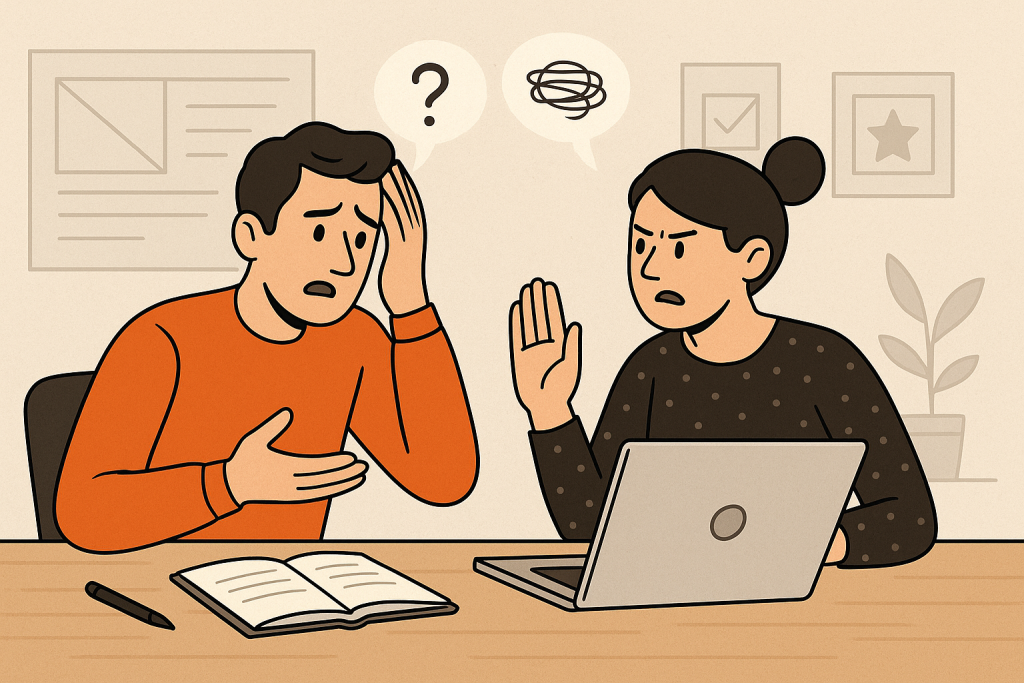If you’re a product manager, chances are you’ve worked with at least one designer who wanted to throttle you. Maybe it was that last-minute scope change. Or the vague feedback. Or the 43rd request to “make it pop.”
Design and product are natural collaborators, but not always natural communicators. Misalignment doesn’t come from malice. It usually comes from unclear roles, broken communication, or a lack of shared context.
In this post, I’ll share what I’ve learned from working with talented (and patient) designers over the years. These are the habits, principles, and small moves that make collaboration easier, and a lot less painful for everyone involved.
Why This Relationship Matters
Design and product are both creative disciplines, but they approach problems from slightly different angles. Product tends to prioritize structure, strategy, and business value. Design prioritizes experience, emotion, and usability.
When aligned, this mix creates balance. But when misaligned, it can lead to:
- Confusing product decisions
- Frustrated designers
- Poor user experience
- Slow execution
Strong collaboration doesn’t mean always agreeing. It means having enough trust to challenge each other productively, and enough humility to know when to step back.
Respect Their Craft (Even if You Don’t Fully Understand It)
Design isn’t just about making things “look nice.” It’s about solving problems visually, emotionally, and functionally. Good designers consider user flows, cognitive load, accessibility, interaction states, and more often simultaneously.
So avoid comments like:
- “Can you make it pop?”
- “It just doesn’t feel right, I don’t know why.”
- “I thought you’d just copy [some popular app].”
Instead:
✅ Ask questions to understand their approach
✅ Be specific about business needs or constraints
✅ Trust that their decisions are intentional
Respect is step one. If a designer feels like they’re just there to “decorate,” they’ll disengage fast.
Speak a Shared Language
One of the biggest sources of tension comes from miscommunication. A product manager might say “we need to simplify this,” but the designer hears “remove important elements.” Or a designer might say “the hierarchy is off,” and the PM nods… without fully understanding what that means.
Invest in learning basic design terminology:
- Visual hierarchy
- Affordances
- Accessibility
- Responsive behavior
- Spacing and alignment
You don’t need to be fluent. Just enough to show you care, ask better questions, and avoid translating everything into “just do what I mean.”
Bonus tip: when reviewing designs, ask “What were you optimizing for here?” instead of “Why did you do this?” – tone and intent matter.
Give Feedback That’s Actually Useful
Design feedback is a skill. And like most skills, it improves with practice.
Here’s what not to do:
- Vague opinions (“I don’t like the color”)
- Prescriptive fixes (“Just change the font to X”)
- Overstepping the role (“I did a quick mockup”)
Instead, focus on what’s not working from a user or business perspective. Try this format:
- What you noticed: “I had to re-read this headline twice.”
- Why it matters: “It might confuse users during onboarding.”
- Open prompt: “Is there a clearer way we could say this?”
Feedback is a conversation, not a command. Invite the designer into the problem, not just your solution.
Align Early, Not Just at the End
Too often, designers get brought in after the problem has been scoped, dissected, and handed down. But great design isn’t a veneer – it’s a core part of the solution.
Involve designers early in discovery:
- Let them hear real user problems
- Bring them into discussions about trade-offs
- Let them ask their own questions
When designers understand the “why,” their work gets sharper – and often faster. They’ll catch things you missed, and you’ll avoid doing three rounds of “can we move this button back?”
Support Their Thinking Time
Design is not linear. It involves a lot of sketching, discarding, rethinking, and exploring. And yet, some PMs unknowingly treat it like a factory: “Here’s the Jira ticket, I need a design by Friday.”
That kind of pressure kills creativity.
Instead:
- Plan for design exploration in your timelines
- Protect their focus time
- Encourage them to show rough work early
Designers don’t need unlimited time, they need realistic time and room to think. Good work rarely comes from a rushed brief and a daily check-in.
Build a Culture of Mutual Ownership
The best product–design relationships are not transactional – they’re collaborative. That means:
- Designers feel ownership of the outcome, not just the mockup
- PMs feel responsible for UX, not just KPIs
- Both care about the problem and the person
Ask for input. Share wins. Talk about trade-offs openly. Make it clear you’re both here to build something meaningful together.

You don’t have to be a designer to work well with one. You just have to care enough to listen, learn, and lead with respect.
When you treat design like a partner, not a service, you unlock better ideas, better execution, and a better product. And you’ll earn a designer’s favorite kind of feedback: “I actually liked working with that PM.”
